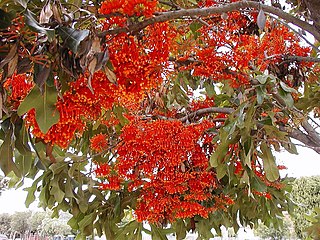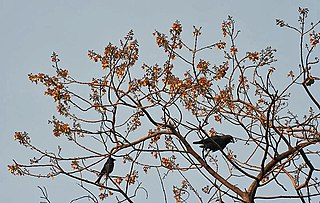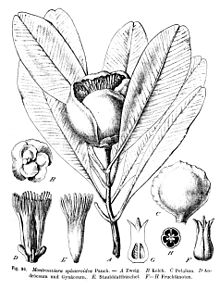
The Clusiaceae or GuttiferaeJuss. (1789) are a family of plants including 13 genera and ca 750 species. Several former members of Clusiacae are now placed in Calophyllaceae and Hypericaceae. They are mostly trees and shrubs, with milky sap and fruits or capsules for seeds. The family is primarily tropical. More so than many plant families, it shows large variation in plant morphology. According to the APG III, this family belongs to the order Malpighiales.

Podocarpaceae is a large family of mainly Southern Hemisphere conifers, comprising about 156 species of evergreen trees and shrubs. It contains 19 genera if Phyllocladus is included and Manoao and Sundacarpus are recognized.

Neoguillauminia is a genus of plants in the family Euphorbiaceae first described as a genus in 1938. It contains only one known species, Neoguillauminia cleopatra, endemic to New Caledonia. Its closest relative is Calycopeplus from Australia.

Moronobea is a plant genus of the family Clusiaceae. They are glabrous medium to large trees with yellow latex. The genus comprises 7 species, native to South America, 5 of which are in Venezuela. It is related to Platonia and Montrouziera.

Malpighiaceae is a family of flowering plants in the order Malpighiales. It comprises about 73 genera and 1315 species, all of which are native to the tropics and subtropics. About 80% of the genera and 90% of the species occur in the New World and the rest in the Old World.

Stenocarpus is a genus of about 25 species of woody trees or shrubs, constituting part of the plant family Proteaceae.

Alangium is a small genus of flowering plants. The genus is included either in a broad view of the dogwood family Cornaceae, or as the sole member of its own family Alangiaceae. Alangium has about 40 species, but some of the species boundaries are not entirely clear. The type species for Alangium is Alangium decapetalum, which is now treated as a subspecies of Alangium salviifolium. All of the species are shrubs or small trees, except the liana Alangium kwangsiense. A. chinense, A. platanifolium, and A. salviifolium are known in cultivation.

Montrouziera cauliflora, the giant Houp tree, is a species of flowering plant in the family Clusiaceae. It is found only in New Caledonia, and is one of the largest trees in the rainforests there. It is found in moist evergreen dense forest of low and medium altitude on all types of soil. The tree has a straight trunk, slightly conical, without buttresses but with a slightly wider base, up to 30 m high and 3 m in diameter, with branches protruding horizontally. Houp trees make fruit but it is not edible by humans. Damage causes the bark to exude a yellow resin, thick and sticky, with no peculiar smell. The bark is dark gray or reddish for individuals in very dense forest, with deep vertical cracks. Houp trees are sacred to New Caledonia's indigenous Kanak people, who traditionally used its wood extensively as a building material. It is threatened by habitat loss.

Cyphophoenix is a genus of flowering plant in the family Arecaceae. It contains 4 known species, all endemic to New Caledonia:. The relationships between Cyphophoenix and some other genera of the tribe Basseliniinae including Physokentia and the New Caledonia endemic Burretiokentia are not clear.

Gmelina is a genus of plants in the family Lamiaceae. It consists of about 35 species in Australia, New Guinea, New Caledonia, Southeast Asia, India and a few in Africa. Some species such as G. arborea have been planted and/or become naturalised in India, Africa and Australia. It was named by Carl Linnaeus in honour of botanist Johann Georg Gmelin.

Kermadecia is a genus of flowering plants in the family Proteaceae. The genus comprises five species, all endemic to New Caledonia. Its closest relatives are Sleumerodendron and Turrillia, of which the species have once been placed in Kermadecia.

Xanthostemon is a genus of trees and shrubs, constituting part of the myrtle plant family Myrtaceae. This genus was first described in 1857 by German–Australian botanist Ferdinand von Mueller. According to different official sources between 46 and 51 species are known to science. They grow naturally in New Caledonia, Australia, the Solomon Islands and Malesia, including the Philippines, New Guinea and Indonesia. The genera Pleurocalyptus and Purpureostemon from New Caledonia are morphologically close to Xanthostemon.
Oncotheca is a genus of tree endemic to New Caledonia. There are two species, Oncotheca balansae and Oncotheca humboldtiana.
Clinosperma is a palm tree genus in the family Arecaceae.
Sleumerodendron is a monotypic genus of plant in the family Proteaceae. The sole species is Sleumerodendron austrocaledonicum.
Dubouzetia is a genus of about eleven species known to science, growing from shrubs up to large trees, in Papuasia and Australasia and constituting part of the plant family Elaeocarpaceae.
Strasburgeria robusta is an evergreen tree with large toothed leaves and large but rather inconspicuous, single, pendulant flowers in a gloomy colorscheme of yellowish with brown markings, with about ten sepals, five petals, ten stamens, a very distinct circular nectar gland with radiating spikes and rather large globular fruits with a long persistent style, with a scent reminiscent of apples, which is endemic to New Caledonia. It is the only recognized species of the genus Strasburgeria.

Stromatopteris is a genus of fern in the family Gleicheniaceae, endemic to New Caledonia. The only species in the genus is Stromatopteris moniliformis. Its closest relative is the more widespread genus Gleichenia.
Menepetalum is a genus of shrubs and small trees in the family Celastraceae. The genus is endemic to New Caledonia in the Pacific and contains four species. Its closest relative is Dinghoua from Australia.
Dicarpellum is a genus of shrubs and small trees in the family Celastraceae. The genus is endemic to New Caledonia in the Pacific and contains four species. Its closest relative is Hypsophila from Australia.













